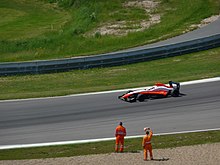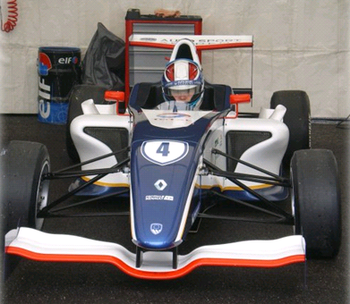Formula Renault

The Formula Renault is a 1968 founded brand formula . It is a combination of several individual national and international racing series.
history
Formule France
In the 1960s, the top national French motorsport association, FFSA , was looking for an inexpensive entry-level formula series. Essential components, including the engine and transmission, had to come from Renault road vehicles built at the time . In contrast, the chassis was freely selectable, as in the Formula Ford . From 1968 to 1971 a championship (Formule France) was held exclusively in France. The 1.3 liter engine and the gearbox came from the R8 Gordini . A vehicle could not cost more than 20,000 francs . Furthermore, tires from the manufacturer Michelin type XAS FF in size 165 HR 13 on steel rims 6.5 × 13 inches were mandatory. The dimensions of the car and the minimum weight of 420 kg were fixed.
The first race took place on March 31, 1968 in Albi , France. The first chassis came from Martini, Grac, Elina, Gerca or GS. In the course of the first season, other vehicle manufacturers were added: Vaillante, Jefa, Fournier, Marcadier, Pygmée and Alpine. The most famous drivers of the time were Larrousse (Alpine), Cadin, Dubos and Beltoise . A total of 17 races took place in the 1968 season. In some cases, it was driven several times on the racetracks in Albi, Nogaro, Pau, Montlhéry, Magny-Cours, Dijon, La Châtre, Rouen and Reims. In 1969 the organizer had too many entries, so there were elimination races at the beginning of the year. From 100 entries only 40 could take part in the season.
In 1970 new manufacturers like Tecno and AGS as well as pilots like Serpaggi, Cudini and Leclère came into the series.
French championship and Eurocup
In 1971 Formula France became Formula Renault. The FFSA, which had organized the championship for the previous three years, ended the Formula France project. Renault set up a department dedicated exclusively to the series and was represented at the races with a service van. There were eight qualifying races in two groups in order to minimize the number of participants for the actual series, followed by 14 more races. Michel Leclère was the champion after 22 races. As in previous years, the tires were free. However, the entire field drove Michelin . Dunlop tried to establish itself as a supplier in the series in 1971 and scored a victory with Cudini (on a Martini), which to this day should remain the only one with Dunlop tires. Dunlop withdrew from Formula Renault halfway through the season.


Final score French Cup : 1st Michel Leclère 234, 2nd Alain Serpaggi 204, 3rd Jannick Auxéméry 188, 4th Alain Cudini 171, 5th Jacques Laffite 155P.
In 1972, in addition to the French Cup, a Eurocup with four races was held in Jarama (ESP), Jyllandsringen (DK), Hockenheim (GER) and Paul Ricard (FRA). The R12 Gordini engine (1.6 l displacement) replaced the R8 Gordini engine (1.3 l displacement).
Final result of the Eurocup : 1st Alain Cudini 48, 2nd Jacques Laffite 39, 3rd Jacques Coche 35
Final score French Cup : 1st Jacques Laffite 294, 2nd Alain Cudini 276, 3rd Jacques Coche 177P
In 1973 and 1974 only one Euro-Cup was held (20/26 races), 80% of which was driven in France. The young drivers who first caused a stir in motorsport were Patrick Tambay and René Arnoux in 1973 . In 1974 it was Didier Pironi and Dany Snobeck . Together with Jacques Laffite and Serpaggi, they should all be able to compete in Formula 1 again. Despite the oil crisis , there were 127 registrations in 1974, from which 40 elimination races were determined for the 74 series.
today
In 2012, Formula Renault (FR) was divided into three categories: FR 3.5, FR 2.0 and FR 1.6 - the numbers indicate the engine displacement .
The 3.5-liter V8 engine used in Formula Renault 3.5 from this year onwards produces 390 kW (530 hp) at 9250 rpm and 445 Nm at 7250 rpm. The 2-liter engine, which is used in the Northern European championship, has an output of 155 kW (210 hp) at 7150 rpm and 220 Nm at 5500 rpm. The 1.6-liter engine achieves 103 kW (140 hp) at 6750 rpm and 157 Nm at 4500 rpm.
vehicle
3.5 liter
A new monoposto from the Italian group Dallara , which is equipped with a Zytek engine, has been running in the 3.5-liter category since 2012 .
2.0 liter
Most 2-liter series have been using a car from the French manufacturer Barazi-Epsilon since 2010 .
Data of the Formula Renault 2.0 from Barazi-Epsilon
| Parameters | Data |
|---|---|
| Photo: |

|
| Length: | 4391 mm |
| Front track : | 1502 mm |
| Rear track: | 1440 mm |
| Construction: |
Monocoque in sandwich construction with honeycomb core and outer layers made of carbon fiber reinforced plastic (CFRP); CFRP vehicle parts |
| Empty weight: | 505 kg |
| Axle suspension: | Double wishbones front and rear, double tube mono shock absorbers at the front and double tube double shock absorbers at the rear |
| Brakes: | internally ventilated brake discs, brake calipers with four pistons |
| Transmission: | sequential; self-locking differential |
| Corridors: | seven forward and one reverse gear |
| Circuit: | Rocker switch; electric, semi-automatic |
| Engine: | 1998 cubic centimeter four-cylinder F4R 832 from Renault |
| Power: | 210 hp |
| Torque : | 220 Nm |
| Speed : | 7500 rpm |
| Fuel tank : | Capacity: 50 liters |
| Wheel size: | front: 9 × 13 inches, rear: 10.5 × 13 inches |
| Wheel size: | front: 20 × 54 × 13 rear: 24 × 57 × 13 |
Before that, a monoposto from the Italian chassis builder Tatuus was standard from 2000 to 2009 and was revised in 2004 and 2007 .
Data of the Formula Renault 2.0 from Tatuus
| Parameters | Data |
|---|---|
| Photos: |
  
|
| Wheelbase : | 2645 mm |
| Front track : | 1772 mm |
| Rear track: | 1675 mm |
| Construction: |
Monocoque in sandwich construction with honeycomb core and outer layers made of carbon fiber reinforced plastic (CFRP); Vehicle parts made of CFRP and GFRP |
| Weight: | 490 kg |
| Axle suspension: | Double wishbones with mono damper at the front and double damper at the rear, actuated via push rods |
| Brakes: | internally ventilated brake discs, brake calipers with four pistons |
| Transmission: | sequential; self-locking differential |
| Corridors: | six forward |
| Engine: | 1998 Renault four-cylinder F4R cubic centimeter engine |
| Power: | 196 hp (144 kW) |
| Torque : | 222 Nm |
| Fuel tank : | Capacity: 38 liters |
| Wheel size: | front: 8 × 13 inches, back: 10 × 13 inches |
| Wheel size: | front: 16 × 53 × 13 rear: 23 × 57 × 13 |
The Argentine Formula Renault 2.0 series, on the other hand, uses cars from the local manufacturer Tito with the IDs 01 (standard vehicle up to and including 2006) and 02 .
1.6-liter
In the currently only 1.6-liter championship, the France F4, a chassis from the French manufacturer Signatech Automobiles with the designation "Formula Academy" is used.
Formula Academy data
| Parameters | Data |
|---|---|
| Photo: |

|
| Length: | 3980 mm |
| Width: | 1700 mm |
| Wheelbase : | 2630 mm |
| Front track : | 1486 mm |
| Rear track: | 1436 mm |
| Construction: |
Monocoque in sandwich construction with honeycomb core and outer layers made of carbon fiber reinforced plastic (CFRP); CFRP vehicle parts |
| Weight: | 470 kg |
| Axle suspension: | Double wishbones with mono damper at the front and double damper at the rear, actuated via push rods |
| Brakes: | Brake calipers with six pistons |
| Transmission: | sequentially |
| Corridors: | five |
| Engine: | 1600 cubic centimeter Renault K4MRS engine |
| Power: | 140 hp |
| Torque : | 157 Nm |
| Fuel tank : | Capacity: 43 liters |
| Wheel size: | front: 8 × 13 inches, back: 10 × 13 inches |
| Wheel size: | front: 16 × 53 × 13 rear: 22 × 54 × 13 |
Michelin tires are usually used.
Championships
Formula Renault 3.5:
Formula Renault 2.0:
- Formula Renault 2.0 Eurocup
- Formula Renault 2.0 UK
- Formula Renault BARC
- Formula Renault 2.0 Northern European Cup (NEC)
- Formula Renault 2.0 ALPS
- Challenge Formula Renault 2.0 Italia
- Asian Formula Renault Series
- Campeonato Argentino de Formula Renault 2.0
Formula Renault 1.6:
There are also various unofficial Formula Renault series, including the Austria Formula Renault Cup and the Formula Renault 2.0 CH in Switzerland .
See also
Web links
Championships:
- Formula Renault 3.5 Series (World Series by Renault): Link
- Eurocup Formula Renault 2.0: Link
- Formula Renault UK: Link
- Formula Renault BARC: Link
- Formula Renault 2.0 NEC: Link or Link
- Formula Renault 2.0 ALPS: Link
- Challenge Formula Renault 2.0 Italia: Link
- Asian Formula Renault Series: Link
- Campeonato Argentino de Formula Renault 2.0: Link
- France F4: Link
- Formula Renault 1.6 NEC: Link
- Austria Formula Renault Cup: Link
Individual evidence
- ↑ A state-of-the-art single seater • Une monoplace à la pointe de la technology ( Memento from March 3, 2011 in the Internet Archive ) (PDF; 125 kB) autosportacademy.com
- ↑ a b c The technology of the "driving school cars for future Formula 1 aces". (No longer available online.) Renault-sport.de, archived from the original on February 16, 2012 ; Retrieved February 21, 2012 .
- ↑ Technical Specifications. (No longer available online.) Renault-sport.com, archived from the original on December 30, 2011 ; Retrieved February 21, 2012 .
- ↑ New look Formula Renault 2.0. (No longer available online.) Renault-sport.com, September 29, 2006, formerly in the original ; Retrieved February 21, 2012 . ( Page no longer available , search in web archives )
- ↑ Presentation. (PDF; 1.0 MB) (No longer available online.) Champ.cc, p. 3 , archived from the original on January 31, 2012 ; Retrieved February 21, 2012 .
- ↑ Reglamento Formula Renault 2.0 Año 2011. (PDF; 224 kB) (No longer available online.) Formulas-argentinas.com.ar, p. 1 , archived from the original on August 20, 2011 ; Retrieved February 21, 2012 .
- ↑ a b Formula Academy. (PDF; 480 kB) (No longer available online.) Autosportacademy.com, pp. 4 and 5 , formerly in the original ; Retrieved February 21, 2012 . ( Page no longer available , search in web archives )


